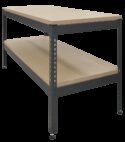Experiment
TM1027

GOVERNORS
Three interchangeable governors (Hartnell, Porter and Proell) show the effects of speed, mass and geometry on governor behaviour.
If you have any questions or you'd like to discuss a product, please call us.
+44 1159 722 611GOVERNORS
A base unit contains a variable-speed motor. The motor turns each of three different governors: Proell, Porter and Hartnell. Note: you test one governor at a time.
Each governor uses rotating weights (masses) and levers to raise a ‘sleeve’. The Porter and Proell governors raise the sleeve against the action of gravity. The Hartnell governor raises the sleeve against a compression spring. A sensor measures the position (lift) of each governor sleeve as it rises.
Additional weights (supplied) allow the user to vary the mass of the sleeve of the Porter and Proell governors. Additional springs (supplied) allow the user to vary the spring rate of the Hartnell governor. Users may also adjust the arm length and rotating mass of the Hartnell governor. The clear dome includes an interlock that shuts off power to the motor. This allows students to see the governors and use them in safety while still giving them access to examine or adjust them.
The base unit includes a motor control and a multi-line display. The control includes unique direction, coarse and fine velocity adjustment and ‘press to stop’ functions. The display shows governor velocity (speed) in units of revolutions per minute and radians per second. It also shows sleeve lift.
The equipment works with TecQuipment’s Versatile Data Acquisition System (VDAS® available separately). Using VDAS® enables accurate real-time data capture, monitoring and display, calculation and charting of all relevant parameters on a computer making tests quick and reliable.
Learning outcomes
- Finding characteristic curves of governor speed against sleeve lift.
- Comparison of governor types in terms of sensitivity, stability and effort.
- On the Porter and Proell governors, the effects of varying centre sleeve mass.
- On the Hartnell governor, the effect of varying: arm length, spring rate, spring compression, rotating mass
- Demonstration of the isochronous condition (Hartnell governor).









